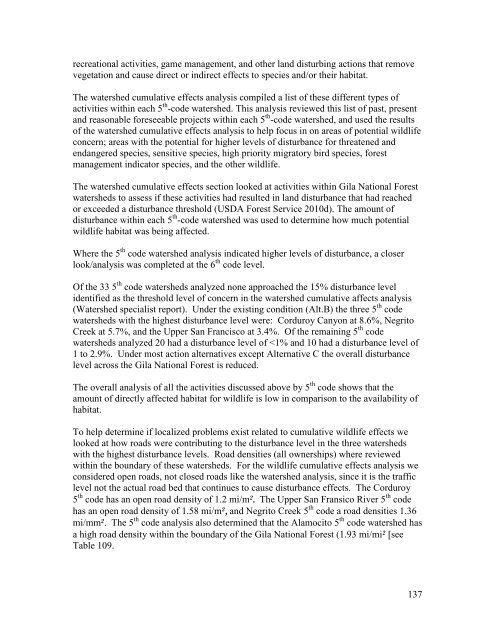Wildlife Specialist report
Wildlife Specialist report
Wildlife Specialist report
Create successful ePaper yourself
Turn your PDF publications into a flip-book with our unique Google optimized e-Paper software.
ecreational activities, game management, and other land disturbing actions that remove<br />
vegetation and cause direct or indirect effects to species and/or their habitat.<br />
The watershed cumulative effects analysis compiled a list of these different types of<br />
activities within each 5 th -code watershed. This analysis reviewed this list of past, present<br />
and reasonable foreseeable projects within each 5 th -code watershed, and used the results<br />
of the watershed cumulative effects analysis to help focus in on areas of potential wildlife<br />
concern; areas with the potential for higher levels of disturbance for threatened and<br />
endangered species, sensitive species, high priority migratory bird species, forest<br />
management indicator species, and the other wildlife.<br />
The watershed cumulative effects section looked at activities within Gila National Forest<br />
watersheds to assess if these activities had resulted in land disturbance that had reached<br />
or exceeded a disturbance threshold (USDA Forest Service 2010d). The amount of<br />
disturbance within each 5 th -code watershed was used to determine how much potential<br />
wildlife habitat was being affected.<br />
Where the 5 th code watershed analysis indicated higher levels of disturbance, a closer<br />
look/analysis was completed at the 6 th code level.<br />
Of the 33 5 th code watersheds analyzed none approached the 15% disturbance level<br />
identified as the threshold level of concern in the watershed cumulative affects analysis<br />
(Watershed specialist <strong>report</strong>). Under the existing condition (Alt.B) the three 5 th code<br />
watersheds with the highest disturbance level were: Corduroy Canyon at 8.6%, Negrito<br />
Creek at 5.7%, and the Upper San Francisco at 3.4%. Of the remaining 5 th code<br />
watersheds analyzed 20 had a disturbance level of
















